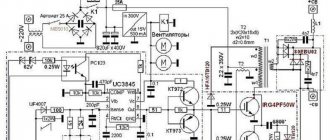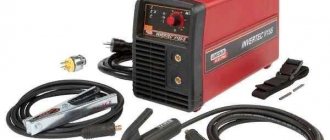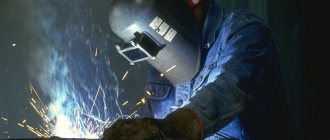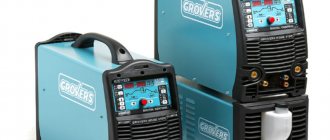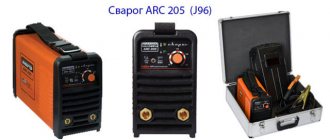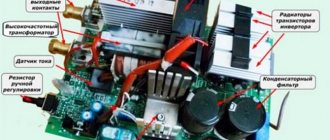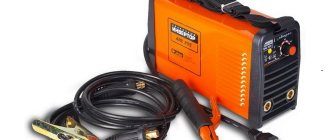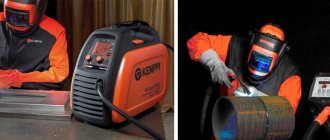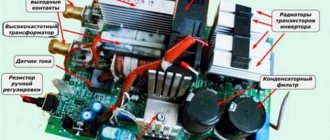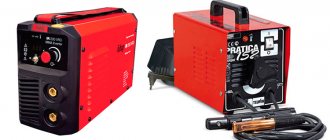The process of manual electric arc welding in English is called “manual metal arc”, abbreviated as “mma”. The abbreviation literally means “manual metal arc”. MMA welding is carried out with a special electrode with a melting core and a coating layer of organic and mineral components. Like other technologies for hot joining metal workpieces, MMA welding forms strong, sealed joints.
The essence of MMA welding
The main feature of MMA welding is the formation at the joint of an alloy containing components of the surfacing and base metal. What is “surfacing” – these are electrodes for mma technology that are melted during operation. Electrodes are marked by alloy:
- with a carbon steel core are designated by the letter symbol “U”;
- highly alloyed - “B”.
During the heating process, the additive and the edges form a common melt pool. Metals are mixed under the influence of an arc. Crystallizing, they form a tight seam, an inseparable homogeneous connection.
To generate an arc in MMA welding, a closed electrical circuit is created; two wires are drawn from the power source. When metal and additive come into contact, the electrical circuit is closed.
Equipment used
The sources of welding current are autonomous generators, step-down transformers, as well as MMA type inverter converters that have appeared relatively recently.
Welding generator
The generator for MMA welding is usually a synchronous electric machine driven by an internal combustion engine, diesel or gasoline. Structurally, such a generator is very close to units designed to provide backup power.
The difference lies in the level of output voltage (for welding units it is usually 70 - 75 Volts) and the presence of a rectifier unit that provides direct current welding.
The identity of the main components of welding and backup generators determines the fact that such machines are usually designed as universal ones. By switching the output voltage level and eliminating the rectifier unit, the unit turns into a regular backup power generator.
Welding transformer
This is a traditional power source used in MMA welding. It is a conventional step-down transformer with a secondary no-load voltage of 50 to 80 Volts. By design, they are three-phase, for a voltage of 220/380 Volts, or single-phase, for 220 or 380 Volts.
Single-phase transformers are typically used for AC welding and do not contain rectifiers. Three-phase converters are equipped with diode bridges and are used for MMA welding with direct current.
This is explained by the fact that single-phase alternating voltage, after rectification, is a sequence of pulsations with an amplitude from 0 to maximum voltage, which causes instability of the arc when welding with a direct current electrode. Therefore, single-phase MMA rectifiers require the use of ripple-smoothing means in the form of powerful chokes and bulk capacitors.
Three-phase MMA rectifiers produce a voltage that is much closer to constant and has slight ripple. Such MMA welding machines are currently most widely used in manufacturing enterprises, providing high quality welded joints.
Welding inverter
It is no exaggeration to say that this type of equipment has revolutionized the welding business. The principle of its operation is as follows: the input voltage (most often single-phase, 220 Volts) is rectified, then supplied to a high-frequency inverting generator (up to 100 kHz), built on powerful IGBT transistors.
After this, the high frequency alternating voltage is transformed to the required level and rectified. As a result, a constant voltage with high-frequency pulsations superimposed on it is formed at the output of the MMA device (or another type).
This property of the inverter apparatus allows you to perform work using various types of electrodes. Welding electrodes designed to work with direct current, as well as those designed for alternating current mma welding, can be successfully used.
Well, the most important thing that inverter technology has brought is that the welding machine has significantly decreased in size and weight. This became possible thanks to the features of high-frequency voltage conversion.
The fact is that a transformer that lowers the voltage with a frequency of tens of kilohertz to the required level is an order of magnitude smaller and lighter than one operating with a frequency of 50 Hz at the same power.
The same can be said about filter capacitors. As a result, instead of a transformer, the movement of which was only possible with the use of lifting equipment, the welder received a portable mma welding inverter, carried on a shoulder strap and performing the same functions.
Advantages and disadvantages
MMA welding does not require complex equipment. Universal, can be performed in any position. Limitations are associated only with the physical properties of the alloys:
- increased fluidity;
- degree of oxidation.
The technology is applicable to most metals; work can be carried out in the field. MMA welding is used for domestic purposes and in production.
Now about the disadvantages:
- difficulty igniting and maintaining the arc;
- harmful factors affecting the health of the welder (vapors generated when electrode coating melts, volatile metal vapors).
The advantages prevail, so MMA technology is applied in various fields.
MMA welding is universal and is used in various fields, for domestic purposes and in production.
Technologies and types
To perform various production tasks, different types of inverter devices are used, differing in functionality:
- for electric manual arc welding (MMA);
- for argon welding with non-consumable electrodes;
- for semi-automatic welding in gas protective atmospheres (MIG/MAG);
- semi-automatic for MIG/MAG and MMA modes;
- universal, through which MMA welding and other welding methods are performed;
- devices for air plasma cutting of metals.
According to technical parameters and level of performance, inverters are divided into:
- Household models, characterized by low cost and simple equipment.
- Semi-professional, equally suitable for home and small workshops.
- Professional, manufactured for continuous use for production purposes.
Welding process technology
The essence of MMA welding is to melt the edges of the metal with an electric arc and fill the joint with surfacing material. The electrodes are a metal rod with a special coating that forms a protective slag layer that prevents oxidation of the melt pool. During the crystallization process, a diffuse layer is formed at the joint - a mixture of surfacing metal and the alloy from which the welded workpieces are made.
Welding mode is the parameters of voltage and current required to form an arc of the required density and temperature. After setting up the equipment, one of the contacts is connected to the electrode, the other to the metal. The circuit closes when the electrode and parts come into contact, and a discharge occurs, generating plasma.
In MMA, the arc is ignited in two ways:
- striking (like lighting a match);
- tapping.
After ignition, it is important to maintain a stable arc. To do this, the electrode is removed from the surface of the part by 2–4 mm. The electrode melts gradually, since the temperature is created only at the tip of the rod. The droplets uniformly replenish the melt pool formed by the molten edges.
Possible electrode movement:
- circular along the axis, the process of melting the rod and forming a protective slag layer is controlled;
- in the direction of the joint, regulates the speed of formation of the joint;
- reciprocating along the seam;
- oscillating from one part to another perpendicular to the joint, a wide one is formed.
What is TIG, MIG-MAG, MMA welding and what does it mean?
MMA welding is manual arc welding using coated electrodes. It is used for welding carbon and stainless steels. Carbon steels can be welded with both direct and alternating current, but stainless steel can only be welded with direct current. The advantages of this type of welding are the possibility of welding in any spatial position, the absence of gas cylinders for welding and the high efficiency of the welding process. Among the disadvantages, it is worth highlighting low productivity and the need to remove slag from parts.
TIG welding is manual welding using non-consumable tungsten electrodes in an argon shielding gas. This method of welding with direct current is used for steel parts, and TIG with alternating current is used for aluminum and its alloys. The advantages of TIG welding are the absence of metal spatter, good control of arc parameters, a neat welding seam and the ability to weld parts of small thickness. The disadvantages are the presence of a gas cylinder, low productivity and high requirements for the selection of an operator. Welding
MIG-MAG is a semi-automatic welding with electrode wire in an inert argon gas environment. In some cases, carbon dioxide may be used. This welding method is used for welding steels (including stainless steel), as well as aluminum alloys.
The advantages of MIG-MAG welding with gas are high productivity, a small amount of smoke and the absence of slag that needs to be removed from the weld. The disadvantages are the use of a gas cylinder and limited outdoor use. Flux cored wire welding has the advantages of no gas cylinders, is always ready to use and is perfect for outdoor work. The disadvantages are the high cost of flux-cored wire and the need to remove slag from the weld metal.
It is worth noting that MIG soldering allows you to work at lower temperatures than MIG welding. This allows the connected parts to be deformed to a lesser extent. The materials are joined using molten solder material. MIG soldering is widely used in body repairs because the zinc coating of steel is not damaged by this method of joining metal.
Features of using MMA devices
When working on MMA machines, a welder requires considerable skill, from the process of igniting the arc to holding it and moving it along a given path.
In addition, it is necessary to melt the metal to a given depth and width, without burning it and preventing uncooked zones. It is much easier for beginners to use a MIG MMA welding inverter - a machine that uses not a piece coated electrode, but a special wire fed into the welding zone in a semi-automatic mode. The welder just needs to press the trigger of the holder - the wire is fed into the welding zone at a speed proportional to the current strength. The welder can only guide the torch along the path of the joint.
The professional MIG MMA welding machine is the best choice for both the novice welder and the professional. You can buy both a transformer and an inverter unit, depending on the needs of the master. But, according to the general opinion of welders, inverters are much more convenient and easier to use.
We invite everyone with experience in MMA welding to share it in the comments to the article. We and our readers are interested in all aspects and subtleties of working with coated electrodes at the domestic and professional level from the point of view of practitioners.
Automatic feeder
The device for constant supply of filler wire delivers without slipping or chewing; a cassette weighing from 5 to 15 kg, with a diameter of 0.8-1.2 mm, is loaded into the inverter. The detailed configuration of the automatic feed looks like this:
- The welding hose consists of a flexible frame cable covered with multi-layer rubber that protects and insulates the power cable. Inside there is a spiral-type channel for continuous wire feeding and an insulated shielding gas supply hose.
- The additive supply mechanism carries out constant movement of the wire along the channel, consists of an electric motor and pressure rollers configured for a certain force.
- Compartment for installing a coil with wound wire. It is located next to the feed mechanism, and the container with the additive is located vertically or horizontally relative to the latter. Fixation occurs with a clamp or nut.
- The feed control unit makes adjustments. There are two methods - electronic, using a rheostat, or mechanical, using replaceable gears.
Modern models have digital displays where the exact wire feed speed is set to ensure the quality of seam formation.
V. P. Ignatenko, education: college, specialty: 4th grade welder, work experience since 2000: Automatic wire feeding makes the work of the performer easier and speeds up productivity, but you need to be careful and have some experience.
The most important characteristics when choosing a device
When selecting an inverter, you should also pay attention to other important parameters and characteristics:
- Availability of additional options that make working with the device comfortable and convenient. These include the “Hot Start” function, which ensures rapid formation of a welding arc; “Anti-sticking” - when the electrode sticks to the surface being processed, the supply of welding current to it automatically stops; “Arc force” is a function necessary for the formation of welding seams located in a vertical plane.
- Suitability of the device for repair. Welders are equipment with a complex structure; their maintenance and repair require special knowledge and spare parts . Therefore, if there are no service centers of specific manufacturers in your place of residence, then it is better to focus on models of other brands.
- Guarantee. Most manufacturers provide a product warranty of up to 2 years; Chinese “no names” and little-known factories either have no return period and free repair period at all, or it is limited to 2-3 months.
- Upgradeable to improve functionality. This option is important only in cases where the device is intended to be used not only for ferrous metals, but also for non-ferrous metals, the high-quality connection of which is possible only in a protective gas environment with a non-consumable electrode (TIG method). In this case, you should choose devices with the possibility of additional connection of cylinders and devices for supplying inert gas.
Sergey Drozdovsky, welder, 22 years of work experience: “MMA welding, like any other, at first may seem too complicated and time-consuming. It is not so easy for beginners to remember the sequence of work and immediately grasp the nuances of the technology. Welding requires a patient attitude and gradual acquisition of skills, therefore, before performing important work, it is better to practice on pieces or scraps of metal, watch training video tutorials.”
How to choose an inverter
When choosing a welding machine, knowing what MMA welding is and how it is performed, future owners most often focus only on the cost of the device.
On the domestic market there are the following main categories of tea-makers:
- cheap Chinese;
- more expensive ones from European manufacturers.
It should be understood that most of the components in equipment of famous brands are made in China. Therefore, when selecting a device, you need to look not so much at the price as at the technical parameters of the device.
The main characteristic of any inverter is its power. The principle of operation of the device is based on the formation of high-frequency pulses coming from transistors under significant voltage - the so-called “power switches”. These elements are needed to increase the current strength when it decreases in the supply network. To protect against burnout of power switches, protection must be provided in the inverter.
In budget models, the presence of protective circuits is not provided, which is why in the event of a sharp voltage surge, the inverter may fail. Therefore, when choosing a device, you should take into account factors such as the stability of the power supply at the place where the welder is used.
An equally important parameter is the power consumed by the device . It is especially necessary to take this indicator into account if the device is intended to be used at maximum welding current. In this case, the power of the electrical network must exceed the predicted load by a margin, taking into account other consumers.
Important! The instructions for the device indicate the characteristics of the fuses installed in the power supply network. You should not use protection with other parameters, as this may lead to malfunctions of the weakest points of the wiring.
Before purchasing a welder, it is important to determine the permissible duration of its non-stop operation, which is indicated in the technical passport. This parameter indicates the operating time of the device at maximum current.
Main types of welding
Welding is a complex process that is performed at a temperature slightly above the melting point of the metal. A peculiarity of welding is that not the entire volume of the metal product is heated, but only the edge of the part that will be connected to another part.
It is most convenient to heat using an electric arc. It is created between a special device - an electrode and an array of metal. In this case, the electrode, in most cases, melts, like the metal. Both edges of the connecting parts form a small stream or puddle of molten metal, which merges into one whole and cools as the electrode moves further.
Often the metal itself is not enough to obtain a strong connection - additional materials are used, usually wire, which also melts and fills the joint area. After cooling, the welded metal, part of the electrode and additives form one monolithic strip - a seam, which is not inferior in strength to the metal itself.
